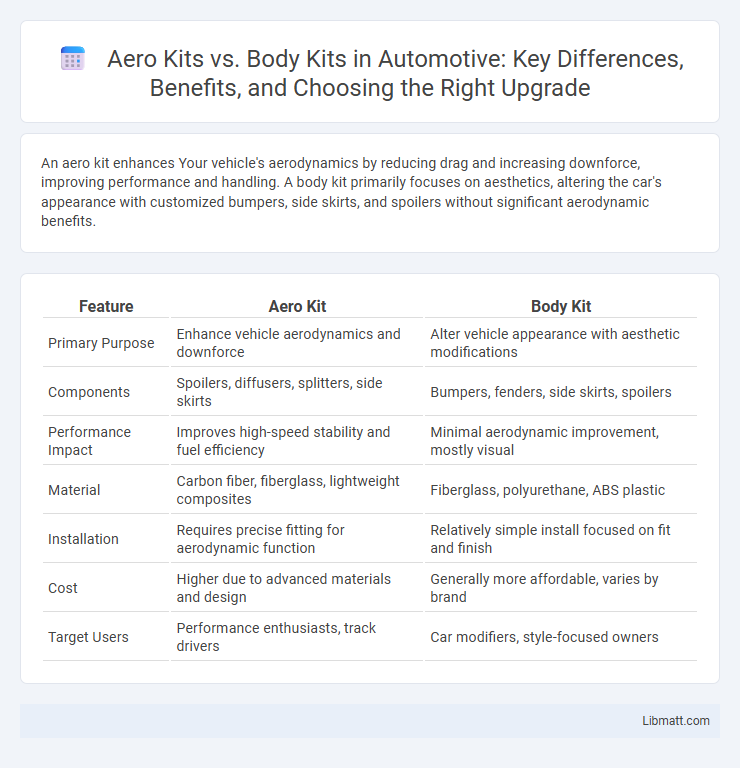An aero kit enhances Your vehicle's aerodynamics by reducing drag and increasing downforce, improving performance and handling. A body kit primarily focuses on aesthetics, altering the car's appearance with customized bumpers, side skirts, and spoilers without significant aerodynamic benefits.
Table of Comparison
| Feature | Aero Kit | Body Kit |
|---|---|---|
| Primary Purpose | Enhance vehicle aerodynamics and downforce | Alter vehicle appearance with aesthetic modifications |
| Components | Spoilers, diffusers, splitters, side skirts | Bumpers, fenders, side skirts, spoilers |
| Performance Impact | Improves high-speed stability and fuel efficiency | Minimal aerodynamic improvement, mostly visual |
| Material | Carbon fiber, fiberglass, lightweight composites | Fiberglass, polyurethane, ABS plastic |
| Installation | Requires precise fitting for aerodynamic function | Relatively simple install focused on fit and finish |
| Cost | Higher due to advanced materials and design | Generally more affordable, varies by brand |
| Target Users | Performance enthusiasts, track drivers | Car modifiers, style-focused owners |
Introduction to Aero Kits and Body Kits
Aero kits consist of specialized components designed to enhance a vehicle's aerodynamic performance by reducing drag and increasing downforce, often including front splitters, rear spoilers, and side skirts. Body kits primarily focus on altering the visual appearance of your car, offering customized bumpers, fenders, and skirts that create a more aggressive or stylish look. Choosing between an aero kit and a body kit depends on whether you prioritize improving handling and speed or enhancing your vehicle's aesthetic appeal.
Key Differences Between Aero Kits and Body Kits
Aero kits primarily enhance a vehicle's aerodynamic performance by reducing drag and increasing downforce through components like spoilers, diffusers, and splitters designed for better airflow management. Body kits focus on altering the vehicle's appearance, often including wider fenders, side skirts, front and rear bumpers, offering a more aggressive or customized look without necessarily improving aerodynamics. While aero kits target functional improvements for high-speed stability and handling, body kits emphasize aesthetic modifications for visual impact.
Purpose and Functionality of Aero Kits
Aero kits are designed to enhance a vehicle's aerodynamic performance by reducing drag and increasing downforce, improving stability and handling at high speeds. These kits include components like front splitters, side skirts, rear diffusers, and spoilers, which work together to optimize airflow around the car. Your choice of an aero kit directly impacts the car's efficiency and cornering ability, making it essential for track enthusiasts and performance-focused drivers.
Purpose and Functionality of Body Kits
Body kits enhance a vehicle's appearance by adding exterior components like bumpers, side skirts, and spoilers, providing a customized and aggressive look. Their functionality primarily focuses on aesthetic improvements and minor aerodynamic benefits, rather than significant performance gains. You can transform your car's visual appeal and create a unique style with a well-designed body kit.
Performance Impact: Aero Kit vs Body Kit
Aero kits are designed to enhance a vehicle's aerodynamic efficiency by reducing drag and increasing downforce, which improves handling and stability at high speeds. Body kits primarily focus on aesthetic modifications without significant performance benefits, often adding weight and potentially increasing drag. Choosing an aero kit over a body kit results in measurable gains in speed, fuel efficiency, and overall driving dynamics.
Aesthetic Appeal: Comparing Visual Upgrades
Aero kits enhance your vehicle's aesthetic appeal by providing sleek, aerodynamic lines that improve airflow and convey a sporty, performance-oriented look. In contrast, body kits focus on visual upgrades with bold, aggressive styling elements like widened fenders and pronounced bumpers, creating a more customized and muscular appearance. Choosing between the two depends on whether your priority is refined aerodynamics or dramatic visual transformation.
Material Selection and Durability
Aero kits are typically constructed from lightweight materials such as fiberglass, carbon fiber, and Kevlar to enhance performance and reduce drag, offering superior durability under high-speed conditions. Body kits commonly use ABS plastic or polyurethane, which balance cost-effectiveness and impact resistance but may not withstand extreme aerodynamic forces as well as aero kits. The material choice directly influences the longevity and performance, with aero kits favoring advanced composites for strength and weight reduction compared to the more affordable and flexible materials in body kits.
Installation Complexity and Costs
Aero kits typically require precise installation involving alignment and aerodynamic adjustments, leading to higher labor costs compared to standard body kits. Body kits are generally easier and quicker to install, making them more affordable for DIY enthusiasts and those seeking budget-friendly modifications. Your choice depends on balancing the advanced performance benefits of aero kits against the simpler, cost-effective nature of body kits.
Popular Brands and Aftermarket Options
Popular brands for aero kits include APR Performance, Rocket Bunny, and Liberty Walk, known for their aerodynamic enhancements that improve downforce and stability. Body kits from companies like VIS Racing, Duraflex, and Seibon Carbon offer a variety of aesthetic upgrades, focusing on styling and customization with affordable aftermarket options. Your choice depends on whether you prioritize performance gains or visual transformation, with many aftermarket options catering to both needs.
Choosing the Right Kit for Your Vehicle
Selecting the right kit for your vehicle depends on your goals, whether improving aerodynamics or enhancing aesthetics. Aero kits are designed to optimize airflow and reduce drag, benefiting high-performance and racing vehicles. Body kits primarily focus on visual appeal, offering custom styling options that transform the car's appearance without significant aerodynamic improvements.
aero kit vs body kit Infographic

 libmatt.com
libmatt.com